Exploring the Markings on the Last Column
Exploring the Markings on the Last Column

Beneath the wreckage of the Twin Towers, a 36-foot-tall piece of steel remained standing, anchored into bedrock. This steel piece was once a part of Column 1001B—one of 47 columns that supported the South Tower’s inner core. Uncovered by workers during the nine-month recovery period, this resilient steel remnant, the last column to be removed from the World Trade Center site, assumed symbolic status for those working at Ground Zero.
Recovery workers, as well as relatives and friends of victims, affixed mementos and wrote inscriptions on the column, filling its surfaces to honor those lost. Now standing in Foundation Hall, the column still bears the markings and memorial tributes. In advance of the 19th anniversary of the end of the rescue and recovery effort, we highlight a few of these markings and tributes and their significance.

O’Berg’s memorial card, taped to the Last Column. Photo by 9/11 Memorial staff.
Dennis O’Berg Marking
On the morning of 9/11, FDNY Lieutenant Dennis O’Berg responded to the Twin Towers with Ladder Company 114. Earlier in the morning, O’Berg had called FDNY Ladder Company 105, the firehouse of his son, firefighter Dennis Patrick O’Berg, and learned that the company had already responded to the World Trade Center site.
Lieutenant O’Berg arrived in lower Manhattan about five minutes before the South Tower collapsed. His rescue efforts soon transitioned into a search for his missing son, who had died as a result of the attacks.
O’Berg continued to search for the body of his son at Ground Zero in the months that followed, always carrying a memorial card with him. O’Berg later taped the card to the Last Column, signing Dennis’s name and ladder company as a tribute to his memory.
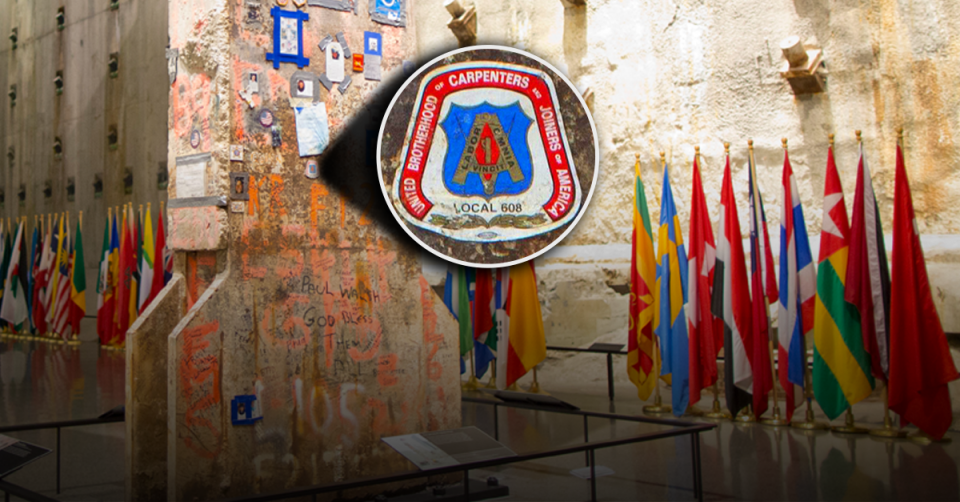
United Brotherhood of Carpenters sticker found on the Last Column. Photo by 9/11 Memorial staff.
Carpenters and Joiners of America Local 608 Stickers
On 9/11, woodworkers from the United Brotherhood of Carpenters and Joiners of America Local 608 responded to the World Trade Center to participate in rescue efforts at the site. They used their skills to search for survivors, and they participated in the bucket brigades, where workers passed debris from person to person to unearth victims in the rubble.
As rescue efforts gave way to recovery, Local 608 members continued to clear debris from the site, performed construction and carpentry work, and stabilized hazardous areas. They also crafted a temporary wooden memorial near West and Barclay Streets, dedicated to all 18 members of the United Brotherhood of Carpenters and Joiners of America who died in the 9/11 attacks.
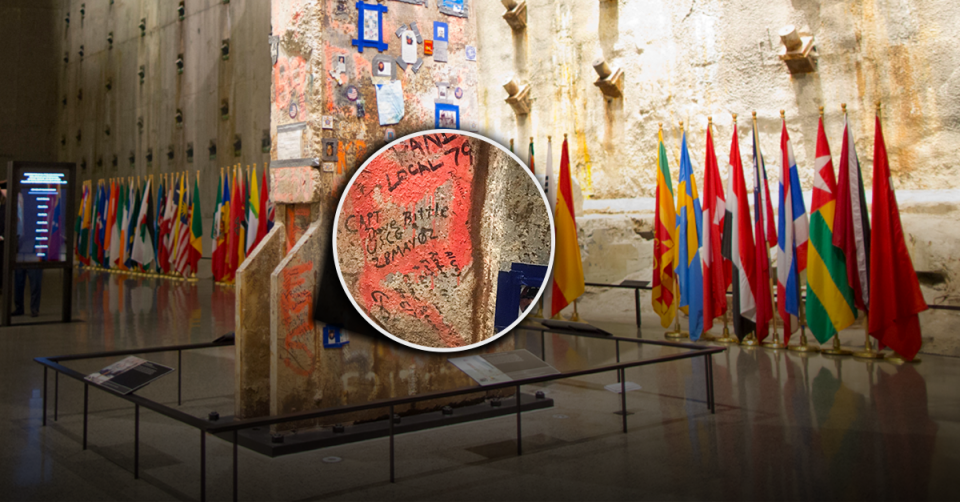
Coast Guard marking on the Last Column. Photo by 9/11 Memorial Staff.
U.S. Coast Guard Marking
Following the 9/11 attacks U.S. Coast Guard (USCG) aided in the evacuation efforts of lower Manhattan and participated in the rescue and recovery efforts at Ground Zero and Fresh Kills, the Staten Island landfill used for the massive evidence, human remains, and property-recovery operation. The Coast Guard’s tasks included directing vessels to transport workers and supplies across the Hudson River to Ground Zero and working with the Environmental Protection Agency to monitor air quality at and around the World Trade Center site. Members of the United States Coast Guard Reserve, the USCG’s standby force, and the United States Coast Guard Auxiliary, its volunteer civilian force, also contributed to rescue and recovery operations.

PAPD markings on the Last Column. Rendering by 9/11 Memorial & Museum staff.
PAPD 37 Markings
Thirty-seven members of the Port Authority Police Department (PAPD), including seven members of its Emergency Service Unit (ESU), were killed as a result of the attacks on September 11, 2001. This was the greatest loss of personnel of any police force in a single event in American history.
“PAPD 37” was one of the first markings spray-painted on the Last Column during the recovery period at Ground Zero. The marking is written in two places on the column. Stickers honoring the PAPD and PAPD ESU were placed alongside one of the markings before the steel column was removed from the site on May 30, 2002.
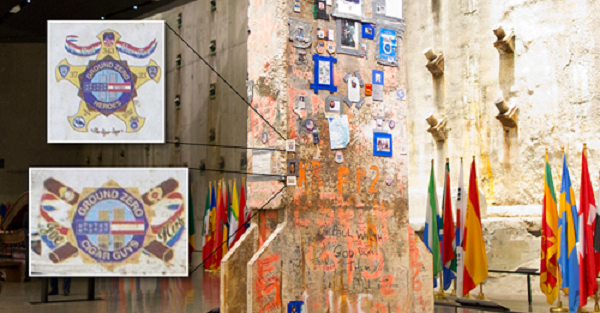
Cigar Guys stickers on the Last Column. Rendering by 9/11 Memorial & Museum staff.
The Cigar Guys Stickers
Joseph Johnson and Herbert Minks, cousins also known as the Cigar Guys of Ground Zero, placed these stickers on the Last Column on May 28, 2002, the day the column was cut down. The stickers, designed by Johnson, honor rescue and recovery workers, commemorates the victims of the 9/11 attacks, and symbolizes Johnson and Minks’ work at Ground Zero.
While providing chiropractic services at Ground Zero, Johnson also distributed cigars to his patients and others at the site. Rescue and recovery workers appreciated the gesture, welcoming a break from their difficult work. Inspired, Johnson and Minks proceeded to hand out cigars every Tuesday night for the duration of the nine-month recovery period.
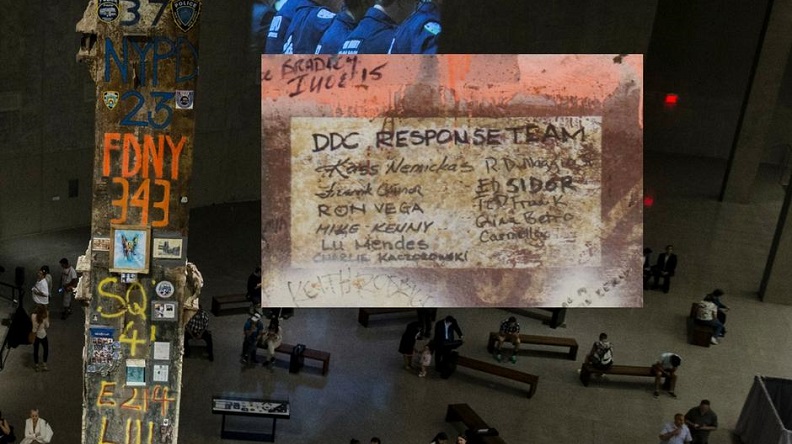
The DDC Markings
The New York City Department of Design and Construction (DDC) managed demolition, excavation, and debris-removal operations at Ground Zero, working with other government agencies and coordinating construction workers from numerous building trade unions.
Together they did what some thought was impossible: they facilitated the expeditious recovery and cleanup efforts at the site with no deaths on the job and few serious injuries.
On May 28, 2002, DDC employees in attendance at the Last Column cut-down ceremony signed their names.
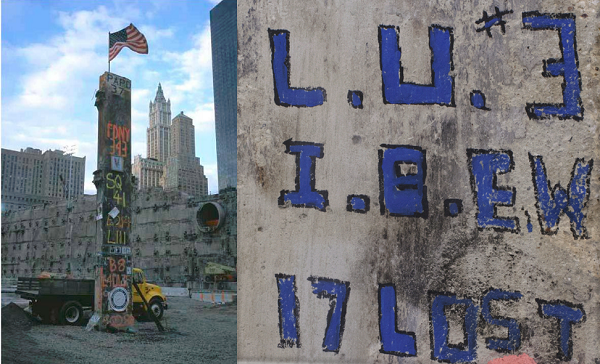
Left: Photograph by Joel Meyerowitz, Courtesy Howard Greenberg Gallery. Right: detail of the “L.U. #3 I.B.E.W. 17 Lost” marking on the Last Column.
International Brotherhood of Electrical Workers Local 3
On the morning of 9/11, members of the International Brotherhood of Electrical Workers (IBEW) Local 3, a New York City chapter, were working for firms across the World Trade Center complex. Some members were stationed on the 95th and 105th floors of the North Tower, the 90th and 105th floors of the South Tower, and in the World Trade Center basement. In the collapse of the towers, Local 3 lost 17 electricians, more than any other local union of construction workers.
Members of Local 3 worked at Ground Zero during the rescue and recovery period. Their work included installing temporary lighting for nighttime search efforts. Additionally, the Local 3 Pipes and Drum band, known as the Sword of Light Band, played at several funeral services for construction workers and first responders killed as a result of the attacks.
In May 2002, at the recovery period’s conclusion, IBEW Local 3 member Kevin Flynn left this marking on the Last Column to memorialize his union’s fallen members.
View the Last Column in person when you book your visit to the 9/11 Memorial Museum.
By 9/11 Memorial Staff
Previous Post
Mourning Brooklyn-Based Artist Samuel Kaplan Whose Painting Is Newly on Display
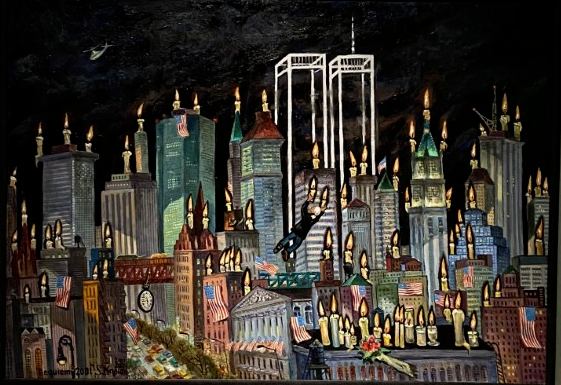
The 9/11 Memorial Museum mourns the death of artist and donor Samuel Kaplan, who died at age 93, one day after his painting Requiem rotated into public view in the Education Center/South Tower gallery of the 9/11 Memorial Museum.
Next Post
9/11 Memorial Marks the 19th Anniversary of the End of the Rescue and Recovery Effort
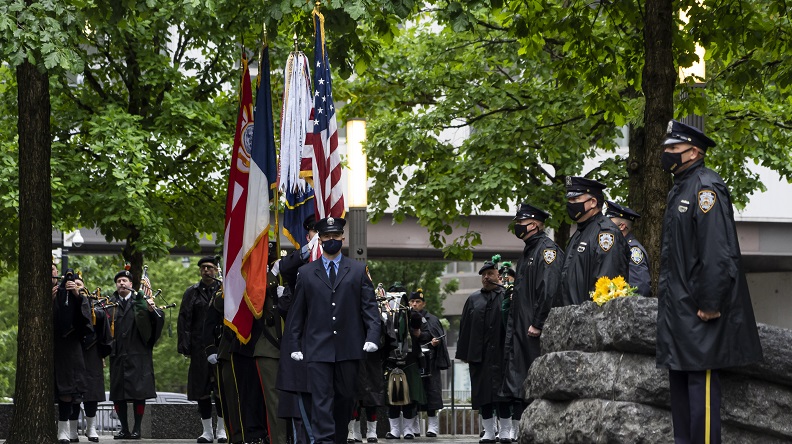
On Sunday, May 30, the 9/11 Memorial & Museum observed an intimate commemorative moment to mark the 19th anniversary of the end of the nine-month rescue, recovery, and relief effort at the World Trade Center site and the two-year anniversary of the 9/11 Memorial Glade dedication.